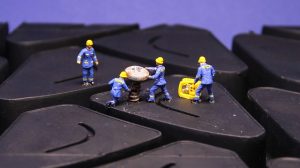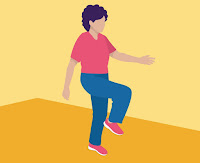Why do we need them in Industries?
Stretching improves muscle elasticity and leads to increased muscle control, flexibility and range of motion. Many stretches before and after a workout, upon waking in the morning or even after a road trip, but what about workplace stretching? Ergonomically sound tools and habits are key to an efficient working environment. Musculoskeletal disorders are one of the hazards in industries.

It is recommended to take frequent, sort breaks or stretch while at the office. Consider taking the time to practice relaxation while on stretch breaks as well. Take a step back between tasks to stretch out tense muscles, relax and take a few deep breaths. Deep breaths supplement oxygen to the blood, which aids in relaxing muscles and maintaining mental alertness.
Injured muscles may not be strong enough to support the joints, which can lead to joint injury. Regular stretching keeps muscles long, lean and flexible and this means that exertion “won’t put too much force on the muscle itself.” says random guys. Healthy muscles also help a person with balance problems to avoid falls.
Exercising is known to cause muscle shortening. The use of proper stretching techniques and regular stretching has the ability to offset this process. by promoting your flexibility, your muscles and joints will be able to move through their full range of motion with ease.
 Warm Up first: Warm up helps to get your muscles warm and loose. a warm muscle is a lot less likely to tear that a cold one.
Warm Up first: Warm up helps to get your muscles warm and loose. a warm muscle is a lot less likely to tear that a cold one.
- March in Place:
- Stand in position.
- Pump arms and legs in opposite directions.
- Make sure that your heels touch the ground.
- Continue 3 to 5 minutes.
- Arm Circles:
- Stand with arm raised horizontally and slightly in front of shoulder, palms down, and feet shoulder-width apart.
- Rotate arms in forward circular motion for 15 seconds.
- Relax.
- Repeat 3 to 5 seconds.
- Knee to Chest:
- Support yourself with one hand.
- With your free hand, pull your knee toward your chest and hold it for 30 seconds.
- Repeat with the other leg.
- Repeat three times for each leg.
- Hip Stretch:
- Stand with one foot in front of the other.
- Place your hand just above the knee of your front leg.
- Gently bend your front knee.
- Keep you back foot flat on the floor.
- Hold 20-30 seconds.
- Repeat with other leg.
- Repeat three times for each leg.
- Thigh Stretch:
- Support yourself with one hand.
- With your free hand, bend your leg back and grasp your ankle.
- Gently pull your ankle towards your body.
- Keep your trunk straight.
- Hold for 20-30 seconds.
- Then repeat with the other leg.
- Repeat three times for each leg.
- Calf Stretch:
- Lean on a solid support with your outstretched hands.
- Bend one leg forward and extend the other leg straight behind you.
- Slowly move your hips forward.
- Keep the heel of your back leg on the ground.
- Hold 30 seconds, relax and repeat with the other leg.
- Repeat three times for each leg.
- Hamstring Stretch:
- Put the back of your heel on a platform at a comfortable height.
- Bend your supporting leg slightly.
 Looking straight ahead, slowly bend forward at the hips until you feel a good stretch at the back of your raised leg.
Looking straight ahead, slowly bend forward at the hips until you feel a good stretch at the back of your raised leg.- Hold 30 seconds and repeat with the other leg.
- Repeat three times for each leg.
We have put together a few reasons why you should be taking stretch breaks at / during work:
- It improves flexibility, leaving your muscles feeling less tense.
- It leaves you feeling refreshed and increases productivity.
- It helps to improve your posture, which reduces back pain.
Working at a desk all day is hard on the muscles, and over time it can start to take a serious toll on them.

Remaining in the same position for 8+ hours a day not only creates muscle tension, but can also contribute to long-term health issues, including:
- Neck and shoulder pain
- Obesity
- Stress
- Lower back pain
- Carpal tunnel syndrome
But when you incorporate stretching into your workday, you can greatly reduce the risk of soft tissue injuries and joint pain.
Stretching will also help to reduce overall muscle fatigue and help to realign your posture.


